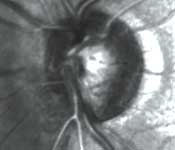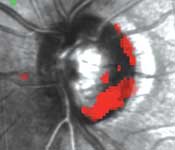Laser scanning system aids in the detection of glaucoma progression
A method of measuring the optic nerve before visible functional damage occurs assists physicians in following and treating glaucoma.
Laser scanning technology that detects visual field changes unseen by the human eye has affected the way glaucoma progression is measured, a physician said.
Theodore Krupin, MD, spoke about his application of the new technology in a telephone interview with Ocular Surgery News.
He said the Heidelberg Retina Tomograph (HRT3) by Heidelberg Engineering allows physicians to follow patients’ glaucomatous progression accurately by measuring subtle changes in the optic nerve, cup and rim in conjunction with the standard method of taking optic nerve head stereophotographs and other techniques of nerve fiber layer imaging.
HRT provides measurements of the optic nerve that the human eye cannot detect, Dr. Krupin said. Those measurements help determine the best course of therapy by detecting the smallest change in glaucomatous damage.
“You can follow and see where the change is happening, and when I start seeing changes on the structure from the HRT, I’m not waiting for a visual field change to happen. I’ll start advancing treatment,” he said.
HRT vs. stereophotographs
|
Images: Heidelberg Engineering |
Before the advent of laser scanning systems, physicians relied on stereophotographs and examinations to determine a patient’s glaucomatous progression, Dr. Krupin said.
Many physicians still use stereophotographs. About 50% of subjects in the Ocular Hypertension Treatment Study had their progression followed by optic disc photographs, he said.
In that study, stereophotographs were read at a reading center by trained staff that had more time to study optic nerve changes in the photographs than most clinicians do in their daily practices, he said.
According to Dr. Krupin, HRT is best at determining structural and functional changes. Stereophotographs detect structural changes of early glaucoma, but HRT provides a thorough assessment of patients in that stage, he said.
“The major advance is the ability of the scanning device to provide measurements that one is unable to obtain by the ophthalmologist just looking at the optic nerve,” he said.
By the time glaucomatous damage can be seen, it has progressed to moderate glaucoma and often requires more progressive treatment, he said.
“When you see a patient for the first time, you don’t know how the story started,” he said. But there’s no question that there’s certain clues in looking at the optic nerve and the width of the rim and looking for notches and other perimeters in the nerve that are characteristic of glaucoma.”
Dr. Krupin still takes stereophotographs of his patients on average of every 2 or 3 years. This helps to track glaucoma progression in multiple ways, but he said he uses the HRT scan to obtain quantitative measurements of optic nerve topography. He is also looking at a process that uses photographs as a live-action film to follow glaucomatous progression in order to examine the effectiveness of other tracking methods.
Technological advances
According to Dr. Krupin, advances in HRT technology and software conversion tools have allowed older scans – taken with software that is not the most current version – to be used on newer systems. The HRT is backward compatible, a feature not available with other instruments. Not being able to access older scans is a disadvantage when following the progression of a patient’s disease.
“Techniques are always changing, and if a technique changes enough, you’ve lost your prior data. You’re starting over and over again with patients,” he said.
Technology advances have also improved analysis of the optic nerve. The system can measure for the size of the optic nerve and take into account how optic nerves can differ in size. Dr. Krupin said bigger optic nerves have more axons, ganglion cell fibers and bigger cups than smaller nerves.
For more information:
- Theodore Krupin, MD, can be reached at University Eye Specialists, 676 N. St. Clair, Suite 1500, Chicago, IL 60611; 312-475-1000; fax: 312-475-1006; e-mail: krupin@northwestern.edu. Dr. Krupin receives an honorarium from Heidelberg for meeting participation.
- Heidelberg Engineering, manufacturer of the Heidelberg Retina Tomograph, can be reached at 1499 Poinsettia Ave., Suite 160, Vista, CA 92081; 760-598-3770; Web site: www.heidelbergengineering.com.
- Erin L. Boyle is an OSN Staff Writer who covers all aspects of ophthalmology.



